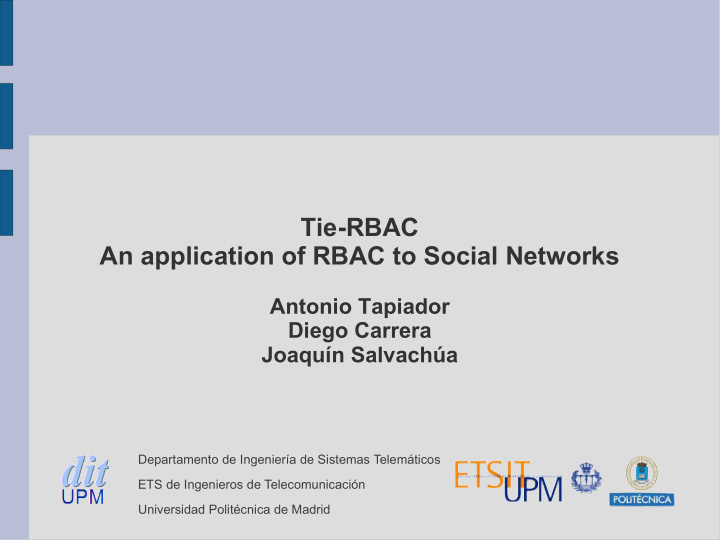



Tie-RBAC An application of RBAC to Social Networks Antonio Tapiador Diego Carrera Joaquín Salvachúa Departamento de Ingeniería de Sistemas Telemáticos ETS de Ingenieros de Telecomunicación Universidad Politécnica de Madrid
Access control models ● Discretionary Access Control ● Mandatory Access Control ● Role-based access Control ● Other (Task/workflows, etc) Joshi J, Aref W, Ghafoor A, Spafford E. Security models for web-based applications. Commun. ACM, 44, 2, Feb. 38–44. 2001
RBAC
RBAC advantages ● Policy neutral ● Simplified security administration ● Administrative roles to manage other roles ● Separation of duties ● Least privilege Joshi J, Aref W, Ghafoor A, Spafford E. Security models for web-based applications. Commun. ACM, 44, 2, Feb. 38–44. 2001
Social Network Analysis ● Understanding the linkages between social entities Wasserman S, Faust K. Social network analysis: methods and applications. New York: Cambridge University Press. 1997.
Tie
Tie-RBAC
Tie-RBAC
Tie-RBAC
Advantages from RBAC ● Policy neutral ● Simplified security administration ● Administrative roles to manage other roles
Tie-RBAC advantages ● Relations are similar to roles ● Managing security while building the network
Implementation: Social Stream ● Core for building social network websites ● Ruby on Rails plug-in ● User, groups, post and comments ● Free / open source ● http://social-stream.dit.upm.es/
Looking for scholar visit!
Questions? atapiador@dit.upm.es
Recommend
More recommend